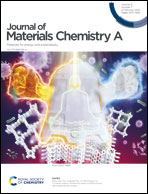Regulation of Ge vacancies through Sm doping resulting in superior thermoelectric performance in GeTe†
Abstract
A high thermoelectric figure of merit ZT of 2.5 at 730 K is achieved in p-type Ge1−xSmxTe through synergetic optimization of electrical and thermal transport properties. Sm doping effectively suppresses the excess Ge vacancies, which is confirmed by positron annihilation measurements. As a result, the intrinsic hole carrier concentration is tuned to the optimum value in GeTe, leading to improvement of electrical transport performance and simultaneous decrease of electronic thermal conductivity. In addition, the Pisarenko curve analysis demonstrates that Sm doping increases the density of states effective mass m* of the materials, which is responsible for the enhanced Seebeck coefficient. Meanwhile, mechanical alloying as a non-equilibrium method is utilized for the preparation of materials in this work, which creates more scattering centers of phonons to suppress the lattice thermal conductivity via the increased grain boundaries. The doped Sm atoms also act as additional scattering centers to further lower the thermal conductivity. As a result, a high power factor of 5409 μW m−1 K−2 and an ultralow thermal conductivity of 1.58 W m−1 K−1 are achieved for the Ge0.94Sm0.06Te sample at 730 K, leading to the superior thermoelectric performance of the materials.



 Please wait while we load your content...
Please wait while we load your content...